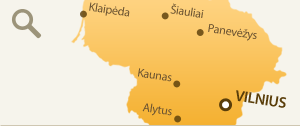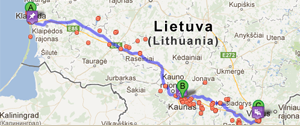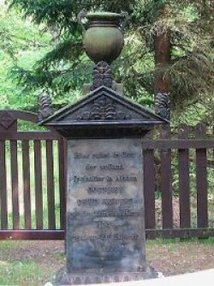Monument to G. D. Kuvertas (Nida)
Curonian Spit scenery was particularly influenced by natures anthropogenic activity phase. XVI and XVIII centuries have seen the destruction of the forests on the Spit along with implicit scenery formed over 5000 years ago. Greening land of the spit was turned into barren sand. This period was particularly hectic. There was no war that has not passed through this land. Particularly hurtful was the Seven Years' War. At that time, new settlers and local people cut the forest mercilessly. Abundant timber resources, good quality pine attracted castle and shipbuilders and merchants. Doom of forest began in 1757 when the Russian army entered the spit, and began to build wide-bottomed galleys in Liepaja and Klaipėda. Over the years, the landscape has changed beyond recognition, particularly the middle part between Juodkrantė and Rasytė. After destruction of forest further disruption of natural basis continued by the wind. Soon bald land turned into barren sand, bringing demise to the population itself.
Feeling the impending death, local population of the late seventeenth century started to correct their errors and by nineteenth century re-created environmentally healthy, aesthetic landscape. In year 1800 the Prussian government ordered to do everything possible to save the settlements on the southern part of the Spit, and it was assigned to experienced in such works senior dune inspector of Danish origin Sioren Bjorn (1744-1819), which a few years ago has issued a Memorandum "How to protect the Spit from sand blizzards by taking care of and greening the dunes”. Biggest merit of Bjorn was that he began to build a protective coastal mound. During 20 years he added 20 kilometers of protective barrier dunes.
In the first part of nineteenth century postal station chief David Gottlieb Kuwertas with his son Georg started planting trees on the Spit. It was difficult grow a tree in the dead sea of sand. Until the protective embankment strip was formed along entire coast seedlings again and again got covered up the sand. Both Kuwertas built wind shields on the western part of the road, and planted drought-resistant plant species. Born and raised here they were well aware of Nida's surroundings, and primarily dangerous places to be greened. For soil and seedling fertilization they used horse manure accumulated in huge reserves at the postal horse yards. The forest they planted saved Nida and prevented the post road from sanding.
Both Kuwertas buried in the old cemetery of foresters in Nida. People of the town immortalized father and son struggle with the sand putting up a cup form monument on their grave. Their gratitude on the monument reads in Latin "... who’s son Georgas Dovydas Kuwertas Meloviškis, who died in 1856 first began to sprout forest trees in a sad barren of Nida. The monument is located at the end of the G. D. Kuwertas street (on the the right side of Klaipeda-Kaliningrad road).
Source: J. Bučas Curonian Spit National Park. Vilnius, 2001
Nearby objects
 Nuomojame nuo balandžio15d. iki spalio 15d, kaina asmeniui 30-40 Lt. (~50.6 km)
Nuomojame nuo balandžio15d. iki spalio 15d, kaina asmeniui 30-40 Lt. (~50.6 km) Horsemarket jojimo paslaugų centras – puiki vieta mėgstantiems žirgus, gamtą ir geras emocijas. (~57.6 km)
Horsemarket jojimo paslaugų centras – puiki vieta mėgstantiems žirgus, gamtą ir geras emocijas. (~57.6 km) Vieno kambario apartamentų nuoma Palangoje vos už 50 Lt. parai (~68.3 km)
Vieno kambario apartamentų nuoma Palangoje vos už 50 Lt. parai (~68.3 km) Viešbutis, restoranas, mini SPA, vyno rūsys, konferencijų salė. (~147.5 km)
Viešbutis, restoranas, mini SPA, vyno rūsys, konferencijų salė. (~147.5 km) Šiaurės Lietuvoje, 28 km nuo Šiaulių, 5 km nuo Radviliškio, 49 km nuo Panevėžio, pakeliui į Tytuvėnus ir Raseinius, miškų apsuptyje, kur… (~168.4 km)
Šiaurės Lietuvoje, 28 km nuo Šiaulių, 5 km nuo Radviliškio, 49 km nuo Panevėžio, pakeliui į Tytuvėnus ir Raseinius, miškų apsuptyje, kur… (~168.4 km) Niekada negali žinoti ar tau patiks, kol pats neišbandai naujos pramogos. (~188.1 km)
Niekada negali žinoti ar tau patiks, kol pats neišbandai naujos pramogos. (~188.1 km) Viešbutis „Metropolis“, garsėjantis įspūdinga istorija, yra vienas iš labiausiai žinomų viešbučių Lietuvoje (~190.6 km)
Viešbutis „Metropolis“, garsėjantis įspūdinga istorija, yra vienas iš labiausiai žinomų viešbučių Lietuvoje (~190.6 km) Viešbutis – Restoranas „Sfinksas“ įsikūręs ramiame, netoli miesto centro esančiame kampelyje. Ramybė, aukštas aptarnavimo lygis, jaukumas –… (~191.8 km)
Viešbutis – Restoranas „Sfinksas“ įsikūręs ramiame, netoli miesto centro esančiame kampelyje. Ramybė, aukštas aptarnavimo lygis, jaukumas –… (~191.8 km) Conviva -nedidelis, jaukus 3 žvaigždučių viešbutis pačiame Panevėžio miesto centre. (~216.7 km)
Conviva -nedidelis, jaukus 3 žvaigždučių viešbutis pačiame Panevėžio miesto centre. (~216.7 km) Nauji, jaukūs butai Druskininkų senamiesty, prie Vijūnėlės ežero. (~238.5 km)
Nauji, jaukūs butai Druskininkų senamiesty, prie Vijūnėlės ežero. (~238.5 km) Druskininkų „Medinukas“ - ko gero pati jaukiausia vieta praleisti atostogas ar savaitgalį populiariausiame kurorte Lietuvoje. (~238.8 km)
Druskininkų „Medinukas“ - ko gero pati jaukiausia vieta praleisti atostogas ar savaitgalį populiariausiame kurorte Lietuvoje. (~238.8 km) Apartamentų Ratnyčėlė Druskininkuose nuoma. (~239.7 km)
Apartamentų Ratnyčėlė Druskininkuose nuoma. (~239.7 km) Kaimo turizmo sodyba „Gervių takas“ įsikūrusi 45 kilometrai nuo Vilniaus centro vaizdingose Trakų rajono Strėvos apylinkėse esančiame… (~252.6 km)
Kaimo turizmo sodyba „Gervių takas“ įsikūrusi 45 kilometrai nuo Vilniaus centro vaizdingose Trakų rajono Strėvos apylinkėse esančiame… (~252.6 km) Visai prie pat Šiaulių miesto 4 žvaigždučių motelis ir puikiai įrengta užeiga.
Jums siūlome 1 liukso, 4 pusiau liukso, 9 dviviečius… (~269 km)
Visai prie pat Šiaulių miesto 4 žvaigždučių motelis ir puikiai įrengta užeiga.
Jums siūlome 1 liukso, 4 pusiau liukso, 9 dviviečius… (~269 km)
Vilniaus pedagoginis universitetas (bendrabutis – svečių namai)
VPU bendrabutis – svečių namai įsikūrę visai šalia Vilniaus senamiesčio, vos keletas minučių… (~280.5 km) Kavinė
Pas mus kvepia kava. Kviečiame stabtelėt, atsipūsti minutėlei ir pasimėgauti kvapnios puikios kavos puodeliu, tokios kaip Jūs… (~282.2 km)
Kavinė
Pas mus kvepia kava. Kviečiame stabtelėt, atsipūsti minutėlei ir pasimėgauti kvapnios puikios kavos puodeliu, tokios kaip Jūs… (~282.2 km) Poilsis, stovyklos, vaikų stovyklos, poilsio bazė „Rūta“, kaimo turizmas, apgyvendinimas, furšetai (~283.5 km)
Poilsis, stovyklos, vaikų stovyklos, poilsio bazė „Rūta“, kaimo turizmas, apgyvendinimas, furšetai (~283.5 km) Drūtūnai – aktyvus poilsis gamtoje. Ignalinos rajone, nuostabios gamtos, ežerų bei upių apsuptyje įsikūrusi didelė, puikiai išpuoselėta… (~319.8 km)
Drūtūnai – aktyvus poilsis gamtoje. Ignalinos rajone, nuostabios gamtos, ežerų bei upių apsuptyje įsikūrusi didelė, puikiai išpuoselėta… (~319.8 km)
Nearby attractions
 The Gallery was founded in an improvised old fisherman’s ship kurėnas. Both an old ship and a modern gallery are the contrast to…(~0.2 km)
The Gallery was founded in an improvised old fisherman’s ship kurėnas. Both an old ship and a modern gallery are the contrast to…(~0.2 km) Close to Nida Evangelic Lutheran Church there is Nida ethnographic cemetery of XIX – XX c. The…(~0.2 km)
Close to Nida Evangelic Lutheran Church there is Nida ethnographic cemetery of XIX – XX c. The…(~0.2 km) The museum founded in 1993 in an old fisherman's house welcomes the visitors with wooden amulets from Juodkrantė's Treasure. (~0.5 km)
The museum founded in 1993 in an old fisherman's house welcomes the visitors with wooden amulets from Juodkrantė's Treasure. (~0.5 km) Cozy Gallery is founded near the house of Thomas Mann. Linen and amber can be purchased here. Helpful employees could tell a story of…(~1 km)
Cozy Gallery is founded near the house of Thomas Mann. Linen and amber can be purchased here. Helpful employees could tell a story of…(~1 km) This is one of the largest lighthouses on Lithuanian seacoast. A 27 meter high lighthouse of…(~1.3 km)
This is one of the largest lighthouses on Lithuanian seacoast. A 27 meter high lighthouse of…(~1.3 km) In 1999 the Sundial was broken by hurricane Anatoly therefore the following description might differ from its present state.(~1.6 km)
In 1999 the Sundial was broken by hurricane Anatoly therefore the following description might differ from its present state.(~1.6 km) Parnidis dune is a favourite place of interest for the holidaymakers. (~1.7 km)
Parnidis dune is a favourite place of interest for the holidaymakers. (~1.7 km) Gliders dune (lit. Sklandytojų kopa), also known as the Great dune – for a long time has been the highest dune on the Curonian Spit.(~2.2 km)
Gliders dune (lit. Sklandytojų kopa), also known as the Great dune – for a long time has been the highest dune on the Curonian Spit.(~2.2 km) This is the widest peninsula on the Curonian Spit, a place reaching up to 3.8 km. (~4.5 km)
This is the widest peninsula on the Curonian Spit, a place reaching up to 3.8 km. (~4.5 km) Hand-built carpet of green dune pines in the hills reveals all its beauty from the old tavern Mountain (in curonian Vecekrugo),…(~5.9 km)
Hand-built carpet of green dune pines in the hills reveals all its beauty from the old tavern Mountain (in curonian Vecekrugo),…(~5.9 km) In the southern part of Preila, at the foot of the dune, the old cemetery of XIX-XX century is located. Last curonians are buried here…(~7.3 km)
In the southern part of Preila, at the foot of the dune, the old cemetery of XIX-XX century is located. Last curonians are buried here…(~7.3 km) Ventė horn is the most wandered away western point of Šilutė region. In its tip for more than a hundred years (1863) there is a…(~13.2 km)
Ventė horn is the most wandered away western point of Šilutė region. In its tip for more than a hundred years (1863) there is a…(~13.2 km) Monument to Königsberg University theology professor, the famous first part nineteenth century man in culture, the Bible publisher,…(~13.4 km)
Monument to Königsberg University theology professor, the famous first part nineteenth century man in culture, the Bible publisher,…(~13.4 km) Žirgų horn lighthouse wasbuilt in 1900 in the Curonian Lagoon at Pervalka behind the Agila bay, in front of the Žirgų horn of cape…(~14.4 km)
Žirgų horn lighthouse wasbuilt in 1900 in the Curonian Lagoon at Pervalka behind the Agila bay, in front of the Žirgų horn of cape…(~14.4 km) Kintai - resort village near Kursiai sea. Kintai is surrounded by beautiful pine-forest (600 ha) - Kintai forest.(~20.9 km)
Kintai - resort village near Kursiai sea. Kintai is surrounded by beautiful pine-forest (600 ha) - Kintai forest.(~20.9 km) Rusnė - one of the oldest settlements in the Nemunas Delta, founded in the XV century Church Towers cock marks the 1419.(~23.4 km)
Rusnė - one of the oldest settlements in the Nemunas Delta, founded in the XV century Church Towers cock marks the 1419.(~23.4 km)
Wooden Sculptures Exposition At The Hill Of Witches (Juodkrantė)
One of the most beautiful and oldest parabolic dunes in Juodkrante is the Hill of Witches. The…(~26.6 km) In 1995, in Juodkrante, the construction works on 2400 m long quay along. Rėzos street were…(~27.3 km)
In 1995, in Juodkrante, the construction works on 2400 m long quay along. Rėzos street were…(~27.3 km) In 1855, while canalizing the waterway near Juodkrantė, the workers discovered amber in the silt soil. Shortly after that, various…(~28.5 km)
In 1855, while canalizing the waterway near Juodkrantė, the workers discovered amber in the silt soil. Shortly after that, various…(~28.5 km) Zemaiciu Naumiestis - the old Zemaitija frontier town with stone based plaza, first mentioned in 1650.(~44.4 km)
Zemaiciu Naumiestis - the old Zemaitija frontier town with stone based plaza, first mentioned in 1650.(~44.4 km)






